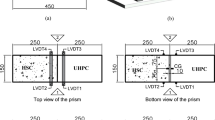Abstract
This paper presents the flexural behavior and strengthening effect of precast reinforced high-strength concrete T-beams strengthened using CFRP sheets with different existing steel reinforcement ratios and CFRP strengthening levels. In general, normally strengthened beams failed by interfacial shear failure (delamination) within concrete, instead of by tensile failure of the CFRP sheets. The delamination occurred suddenly and the concrete cover that was cracked vertically by flexure was spalled off due to the impact energy. The strengthened beams were stiffer than the control beam before and after yielding of the reinforcement. The ultimate load considerably increased with an increase in the number of CFRP layers, while the ultimate deflection significantly decreased. The tensile force of the CFRP sheets and the average shear stress of concrete at delamination failure were linearly proportional to the CFRP strengthening level. Therefore, the increment of the ultimate load obtained by strengthening was linearly proportional to the strengthening level. On the other hand, the steel reinforcement ratio does not seem to have a significant effect on the increment of the ultimate load.
Similar content being viewed by others
References
ACI Committee 440. (1996).State-of-the-art Report on Fiber Reinforced Plastic (FRP) Reinforcement for Concrete Structures, American Concrete Institute, Michigan.
ACI Committee 318. (1996).Building Code Requirements for Reinforced Concrete and Commentary (ACI 318-96), American Concrete Institute, Michigan.
Meier, U. and A. Winistörfer (1995). “Retrofitting of Structures through External Bonding of CFRP Sheets,”Proceedings of the Second International RILEM Symposium, RILEM Proceedings 29, Taerwe, L., Editor, E & FN Spon, pp. 465–472.
Naaman, A.E., S.Y. Park and M.M. Lopez (1998).Flexural Behavior of RC Beams Strengthened Using CFRP Sheets, University of Michigan, Research Report No. UMCEE 98-21, August 1998.
Plevris, N. and T.C. Triantafillou (1994). “Time Dependent Behavior of RC Members Strengthened with FRP Laminates,”Journal of Structural Engineering, ASCE Vol. 120, No. 3, pp. 1016–1042.
Saadatmanesh, H. and M.R. Ehsani (1991). “RC Beams Strengthened with GFRP Plates. I: Experimental Study.”Journal of Structural Engineering, Vol. 117, No. 11, pp. 3417–3433.
Saadatmanesh H. ({dy1994}). “Fiber Composites for New and Existing Structures,”ACI Structural Journal, Vol. 91, No. 3.
Author information
Authors and Affiliations
Additional information
The manuscript for this paper was submitted for review on June 20, 2001.
Rights and permissions
About this article
Cite this article
Park, S.Y. Ultimate strength of precast high-strength concrete beams strengthened in bending with different steel and glued FRP reinforcement ratios. KSCE J Civ Eng 5, 339–345 (2001). https://doi.org/10.1007/BF02829108
Issue Date:
DOI: https://doi.org/10.1007/BF02829108




